News
FOCUS: Glyn Davies
26 November 2020
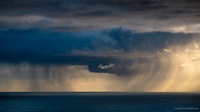
© Glyn Davies. 'Irish Sea Squall' South Stack
Prolific AOP Photographer Glyn Davies, shoots exceptional vast landscapes, prints of which he sells from his gallery in Wales. The onset of the pandemic took an unknown turn for Glyn as he arrived in South Africa for a family wedding and what he thought would be a month of adventure. Sadly it all come an abrupt holt when they suddenly went into lockdown. Finding himself confined to a house with a walled garden with no escape for a month, Glyn recorded the journey through his iPhone as his only solace, and shares it with us in Spotlight. Read on for an in-depth account of his experience as well as hearing about how he got to where he is today.
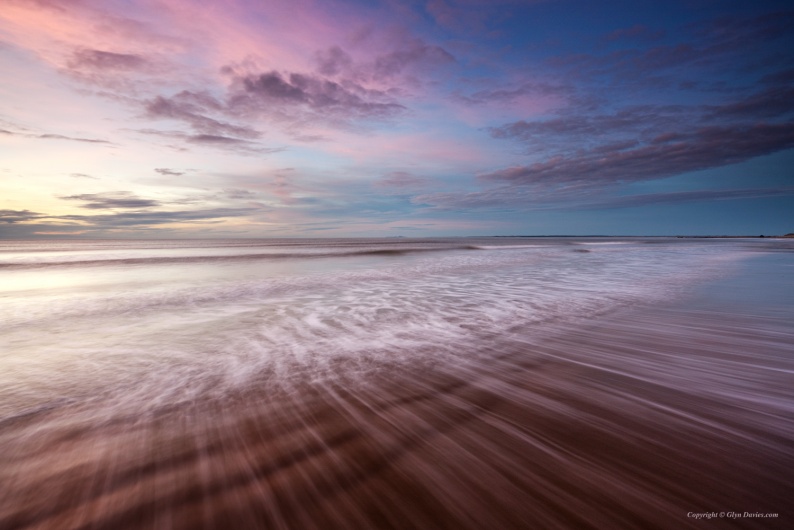
© Glyn Davies. "Rippled Pink” Dinas Dinlle
When did you first pick up a camera and what did you point it at?
Well, the first time for real, not just family snaps, was actually during my school years in Falmouth. I was mad keen on geography and utterly fascinated by landforms. I’d been on school trips to Dorset & Snowdonia with my amazing geography teacher Rusty Holt (whom I met this year, 38 years after last seeing him!) and I wanted to know everything about how landscapes were formed. A few of my classmates had SLRs and were able to stick enprints of landforms into their projects. I thought that was amazing and desperately wanted my own camera. An artist friend of my parents gave me a post-war Leica rangefinder to get me going.
I went to the Yorkshire Dales with my mum to photograph the limestone features around Gordale Scar and Malham Cove for a school project. It wasn’t an all-singing all-dancing Canon like my friends had, but at least it was a camera, and I could make pictures. It was a bottom-loader and I struggled to get the cassette in. Anyway, I was super-excited, and we spent the whole day photographing, reading the weather icons on the film box to see which settings to use.
We returned to Falmouth & dropped the film into the local camera shop. A few days later we went back to pick up the prints, to discover there weren’t any! The film leader hadn’t engaged so I hadn’t actually taken anything. I was devastated! There and then I part exchanged the Leica for a Nikon FM and this made me so happy. The very first picture I took with that camera? A yoghurt pot on our cottage kitchen table!
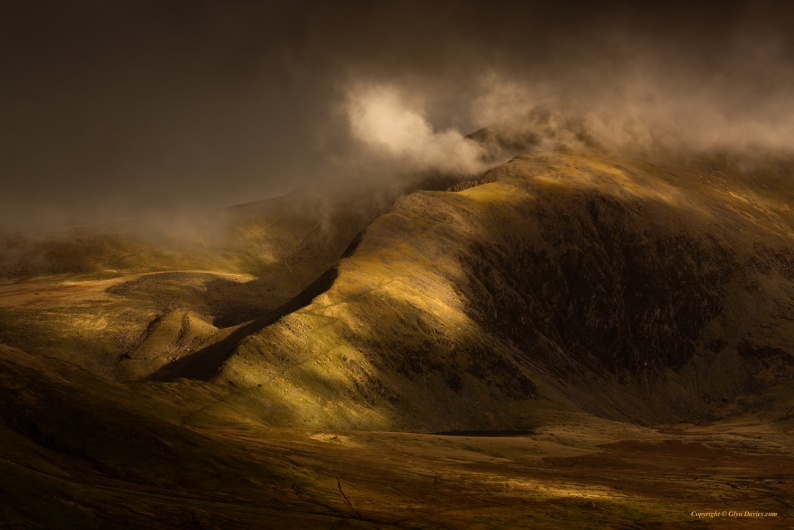
© Glyn Davies. 'Light Notes’ Yr Wyddfa (Snowdon)
The pandemic changed life as we knew it for many of us. Your showcase in Spotlight, Stranded in South Africa - Kept together by an iPhone takes the viewer on a journey of isolation during lockdown, can you share your story?
In March we flew to South Africa to stay with relatives for a family wedding. We had deliberated hard about going, but as things still seemed mostly ‘normal’ we hoped it would be OK. A few days after arriving in Cape Town however, the wedding was cancelled! A day later and President Ramaphosa ordered a total block of South African airspace and a complete lockdown of citizens, couldn’t even leave your house other than for food or medical help. Armed police patrolled the streets.
Each night we watched the news about the viral spread and the dramatic measures being taken to try and reduce the risk to thousands of poor township residents in crowded habitations. Our holiday insurance would only have covered repatriation not medical care, so I went to bed each night full of worry. I awoke nightly with nightmares about catching the disease and finding ourselves in an overcrowded provincial hospital, possibly dying alone thousands of miles from home, with families never knowing where our bodies were. We listened to horrifying news about Italy where Covid-dead were being left in body bags outside hospitals that couldn’t cope with the sheer numbers of infected people. Locally we heard about food lorries being raided, and a friend of the family being burgled twice, not for money but for food!
Things were bad in the UK by now, indeed much worse than South Africa, but it was the feeling of helplessness that I found most depressing; of not being with our own family back home; of not having the amazing NHS to care for us; of being unable to do anything effective to save my business; of being unable to exercise or see any form of view; of not being in our own house, able to say what we want, watch what we want, eat what we want and just be ourselves. All these things intensified my stress beyond the virus itself. It must have been increasingly difficult for our relatives as well, being constant hosts to us, rather than having their own space, mentally and physically.
Although it was summer there and we were staying with welcoming relatives, who have a lovely garden and small pool, the feeling of entrapment, of being enclosed and out of control in a fearful situation was something I struggled hard with. I was close to a break down and tearful most days. My partner Jan is a senior ITU staff nurse with an incredible ability to be in control but I knew she was struggling too, and yet here she was trying to stop me from breaking down, which has left me feeling guilty even now.
My only way of keeping my mind together, day after Groundhog Day, with no freedom whatsoever, was to start photographing our garden environment. It was lush and beautiful but when you spend twelve hours a day in that same environment it becomes quite demanding to continually find something new. We could hear the roaring waves of the Atlantic Ocean just 300 meters away but we weren’t allowed to even see it let alone walk on the miles of white sand. There was no view from this beautiful garden, surrounded as it was by high walls and electric fences, so the garden itself WAS the view. I hungered after open spaces and I was becoming claustrophobic.
I started to see landscapes within the garden. Small plants and bushes become jungles. The pool become a lake and then an ocean. I started looking to the sky and enjoyed it reflecting in the water. I was looking for anything that reminded me of natural places and nature. I couldn’t cope with using my professional camera - I needed the ease of my iPhone and the ability to respond to visuals the instant my mind felt connected. I relished the only control I had at the time, that of composition and creating order out of chaos. I found purpose, no matter how insignificant in world terms, creating a series of images that helped to calm me during confinement. I constantly looked for new subjects rather than revisiting old ones. Re-shooting would have re-affirmed my sense of entrapment. New subjects meant looking forward, a future, a hope.
After almost a month of unsuccessfully trying to arrange a flight home, the British Embassy and managed to negotiate temporary opening of airspace for repatriation flights and thankfully we were amongst a lucky few to get a flight home.
Freedom is everything. Being denied access to nature, friends and family, even just the ‘right’ to wander is for me at least, mind-crushing. What I’ve also confirmed is that my photography is so much more than a profession; it’s a need, a pacifier and a catalyst for clarifying thoughts. In such a mentally dark place, making pictures became a therapeutic light.
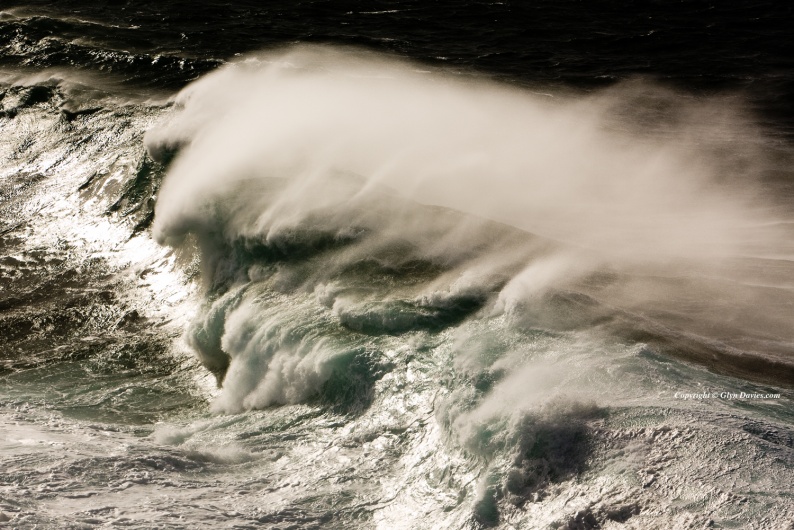
© Glyn Davies. "Out of Darkness” Atlantic Ocean
What is it that draws you to Landscape photography?
Although my prime focus in the beginning was landforms, I soon become hooked on photography itself. I became as fascinated by the process and art of photography, as the landscape. I took an Art Foundation Course at the Falmouth School of Art where I was tutored by fine-art photographer Jem Southam, who got me to explore other ways of viewing the landscape. His book, ‘The Red River’ has been inspirational ever since. I guess that I’m looking for honesty within dramatic light conditions whereas Jem seemed to seek honesty under bland lighting.
We were brought up in rural Cornwall so an immersion, even obsession with nature was inevitable. My parents are both professional artists and we would regularly travel around Cornwall, walking the coastline and spending days at the seaside. We were encouraged to draw & paint the landscape whilst we were out and about. My dad is a also keen cyclist and so I rode thousands of miles around Cornwall with him over the years. I started sailing in my teens, and an appreciation for the power & danger of the sea held me in awe.
Over the years I’ve also spent much time surfing and rock climbing, so almost everything I’ve done in life has intensified my connection with nature, the oceans, cliffs, moors and mountains. I love travel, but mostly to see new landscapes rather than for human interaction. I have an unsatiable hunger for the great outdoors. I literally suffer mentally if I can’t get into nature and landscape. My photography fulfils a ‘creative’ need within me for sure, but my image making is almost invariably about sharing with an audience some of the amazing spiritual excitement of light, weather, landscape and places that I’ve enjoyed being in.
I’m not religious but I do feel a kind of spiritual connection with certain landscapes and get as emotionally moved by spectacular light and weather as when listening to beautiful classical music. For me it’s an emotional and existential experience, being in wild landscape. I can’t do crowds and I shun noise and chaos - I need solitude whenever I’m in the landscape. It’s guess it’s hardly surprising that landscape and travel photography remain activities that connect with my soul in a way that other fields of photography don’t.
That said, I’ve just completed and thoroughly enjoyed an exhibition project with the NHS, where I got to photograph some brave and amazing people who have been helping to save lives during this horrific pandemic. Although I stress in large crowds, I do love 1-1 interaction with people and making environmental portraits of them. My degree at Harrow was very focussed on photojournalism and editorial photography, and if in the future I’m unable to walk the mountains or get into wild landscape, then shooting considered portraits, conveying some sort of honest impression of the subject, will be an alternative I’d really enjoy.
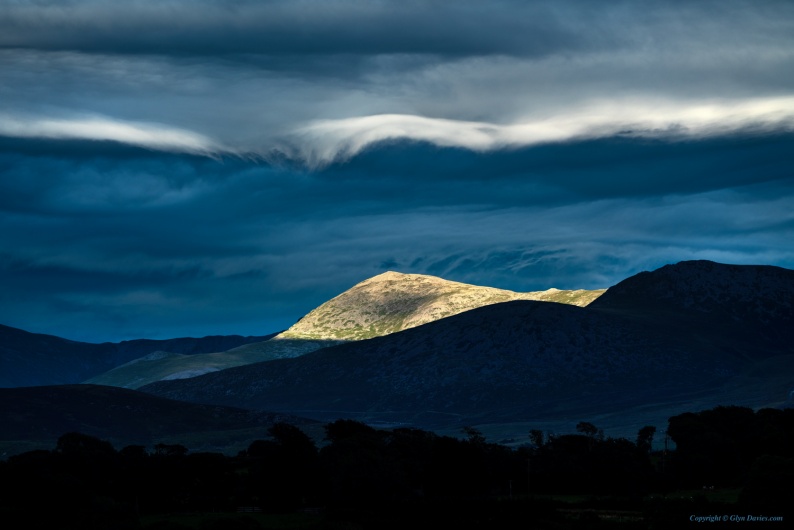
© Glyn Davies. "Peak Beneath a Blue Sea" Carnedd Dafydd
What’s the most magnificent place you have found yourself shooting in?
There are so many amazing places in the world, but without any question, mostly because of its vastness and solitude it is Namibia! I love deserts - the heat, emptiness and inhospitality of them - and I was utterly and completely blown away by the sheer scale of the Namibian landscape; 825,000 square miles and much of it just arid desert, imposing if eroded volcanic peaks and of course the incredible, fog-shrouded sand dunes of the Skeleton Coast.
We travelled hundreds of miles a day so didn’t have the opportunity to shoot everything in colourful dawn or dusk light, but I started to enjoy the starkly lit brilliance of the parched landscapes anyway, even in the burning overhead sunshine. I become intrigued by the incongruity of subjects that I stumbled across; a lone tree growing out of dust; abandoned vehicles stripped to bare metal by the sun; volcanic fragments resembling mini sculptures; and surprisingly for me, surreal occurrences of man-made objects that appeared out of nowhere.
One area I refused to visit as I’d heard it was ridiculously busy, was the famous dead-tree punctured clay pan of Deadvlei near the mountainous sand dunes of Sossusvlei. The thought of negotiating hundreds of intrepid snappers all scrapping to photograph the place filled me with dread, even though I desperately wanted to see the place. If I ever go back to Namibia, I will hire a guide who could advise me of the best times to explore the area, but the anarchist in me still means that if a place is extremely popular, then I won’t want to go there anyway!
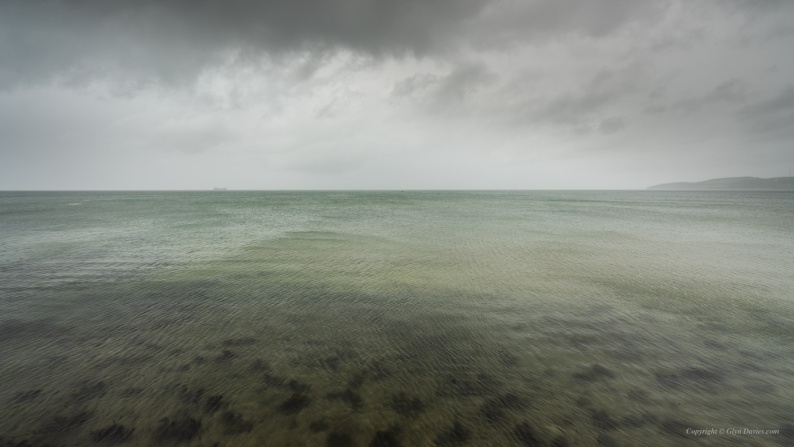
© Glyn Davies. 'Even in the Rain’ Benllech
Can you tell us more about your gallery in Wales?
Until 2002 I was shooting much commercial and industrial work, from aerial photography to power stations and factories. I’ve photographed products, interiors and locations. I shot for sailing and business magazines as well as Country Living and so on, but I’ve never once stopped shooting landscapes, for all the reasons I’ve mentioned earlier in this interview. However, I wasn’t selling any prints to anyone.
An entrepreneurial client of mine mentioned that he’d seen a retail unit come up for rent in the Anglesey town of Menai Bridge. He thought it would be good for me to stop working from home and have a proper business location. I was scared about the finances but for some reason, I went for it anyway. Initially it was just an office and a place to show commercial work, but gradually visitors started to ask about my prints on the wall. I started to introduce more personal prints into the display, and it snowballed. Within 3 years I had gone from 99% commercial work and 1% print sales to just 30% commercial work and around 70% print sales. When my lease ended after 3 years, I luckily managed to find larger premises on the same street, for less than half of the previous rental! After £21k refurbishing the place & making it suitable for hanging pictures, I finally a had a place that looked and felt like a proper gallery. By around 2009 I had stopped almost all commissions to concentrate on personal work and running a retail gallery.
Last year I even closed down my studio to create a fourth gallery room. I have two large printers so that I can keep all printing in-house, and I source my framing from local suppliers. Now 100% of my regular income is purely from selling my prints and books, with occasional brilliant commissions like the recent one from the NHS, providing welcome bonuses. I have never been happier, though sometimes I worry about all of my eggs being in one basket. My landscape work has led to numerous TV programs and I’ve published five books of my work, three of which sit on a Royal coffee table somewhere, so specialising purely in landscapes has had some major benefits.
I’m very selective about what goes on my walls. Yes, I’m a gallery and yes people want to buy art, but I am very aware that most customers are visitors to this stunningly beautiful region and want art with a connection to the place. If I was in London or another major city, I believe I could sell more varied subjects as buyers would buy more art for art’s sake. I sometimes get disappointed that some of my favourite images never end up on my gallery walls but that’s reality, and I’m nevertheless happy doing what I do, living in a beautiful if impoverished region, because I don’t have to worry about contracts, negotiations and copyright. If people like my work they buy it, if they don’t, they walk out. I love the simplicity and the peace that comes with that.
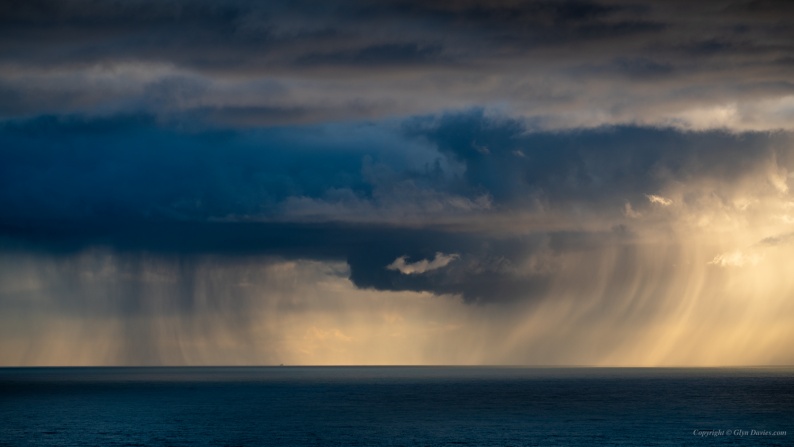
© Glyn Davies. 'Irish Sea Squall' South Stack
What does being a member of the AOP mean to you?
I joined the AOP many moons ago because I liked the work that I saw in the Awards. I had the most amazing business and legal advice from Gwen Thomas, before I even became a member, so following that I just felt it right to support an association that seemed to be about top-end professional photography, and not the dicky-bow obsession of some other pro-organisations. I once saw Martin Beckett at a trade show and apart from admiring his photography I just thought “man he’s so cool”!
I subsequently joined, and enjoyed being part of, the Northern Committee (sadly missed), that met in Manchester. I loved being part of a group of genuinely full-time commercial & advertising photographers. The amazing admin Cheryl Twomey introduced me to amongst others, the incredibly talented Tim Ainsworth who owned the studio, and other northern stalwarts, Graeme Cooper, Ed Horwich & Doug Currie.
Recently the AOP provided me with documentation to help facilitate me working in the landscape throughout lockdown. This small gesture is just part of what makes the AOP great, alongside the bigger projects about ethics, copyright and professional practice.
I’ve had a fair bit of other help and support over the years from the AOP though, from coverage of exhibitions, to articles in Image magazine. I staged a lovely exhibition at the AOP Gallery a few years ago and the staff couldn’t have been more helpful. I met some awesome folk during the show, including the eminent Adam Woolfitt.
Even though I do little commercial work these days, as people now only see me as a landscape photographer, I still want to be part of the AOP. It makes me feel more connected somehow to the London pulse, and of course I still enjoy seeing the annual awards. I’ve had some success in the AOP Open but I don’t think my sort of landscape photography is quite what the Awards are heralding as fashionable these days, but I’ll just keep on doing my thing, which has kept a roof over my head and happiness in my heart for nearly 40 years.



